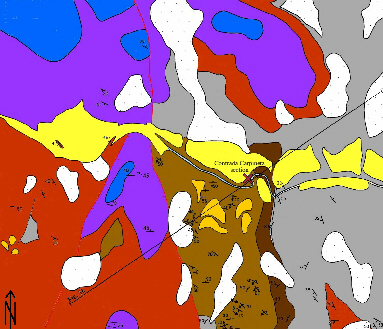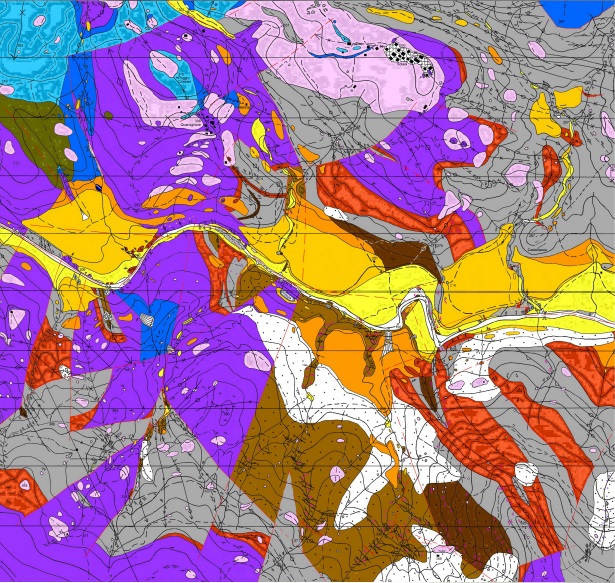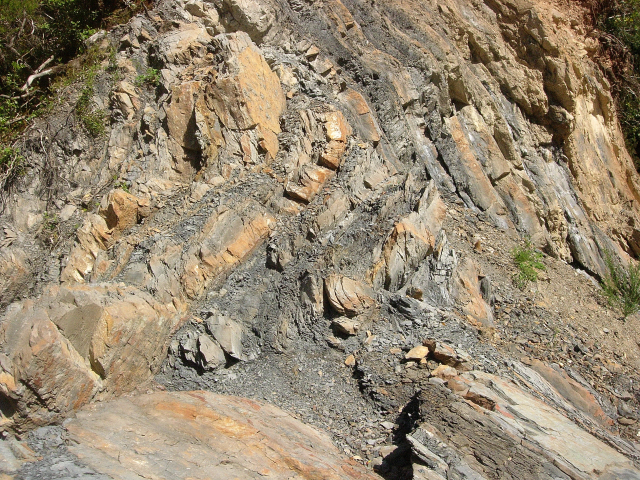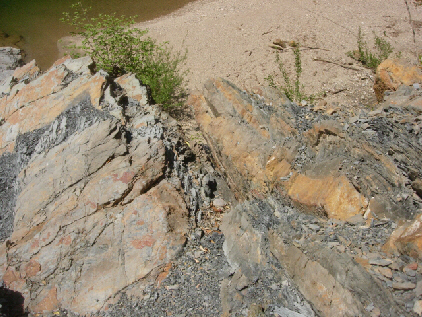Comment on the paper The paper deals with the geological age
and deformation of the Farma Formation (Tuscan
Palaeozoic), constituent of the Tertiary metamorphic core
complex (MCC) of Monticiano-Roccastrada. This MCC is
subdividable into several tectonostratigraphic subunits,
which are supposed to be stacked in E-vergent thrust
sheets. Criteria for that subdivision are zonaly
distinctive degrees of deformation and metamorphism as
well as the specific lithofacies of the late palaeozoic
formations characterising each subunit. One specific
lithofacies is the Farma Fm., element of the
tectonostratigraphic Monte Leoni - Farma subunit, thought
to be the easternmost and deepest one of that MCC
(Lazzarotto et al. 2003). - The authors use in their Fig. 1b the
outline map of Lazzarotto et al. (2003). The main
lineament, considered to be an E-vergent, ca. N-S
striking thrust, is thought to separate the Monte Quoio -
Montagnola Senese subunit from the Monte Leoni - Farma
subunit. According to own observations, however, the
lineament does not fulfil the criteria of separation
south of river Farma: because the late palaeozoic units
outcropping E of Roccastrada do not represent lithologies
comparable to the Poggio al Carpino Formation,
characterising the Monte Quoio - Montagnola Senese
subunit. Mentioned late palaeozoic units E of Roccastrada
are, however, comparable to lithologies of the Monte
Leoni - Farma subunit. Therefore the strike direction of
that main tectonic lineament S of river Farma should
better be NE-SW (and not N-S). - Referring to the map presented by the
authors in Fig. 3a: Despite access impeded by dense
forest, despite scarce outcrops and despite the
difficulty to discern similar lithologies: According to
own observations, the data in Fig. 3a are, concerning
mapped geological formations and their boundaries, too
simplified/generalised (see confrontation below): better
lithological differenciations between Monte Quoio Fm. and
Civitella m.ma Fm., between Monte Quoio Fm. and Upper
Verrucano as well as between Tocchi Fm. and Calcare
Cavernoso should have been carried out. The formation
boundaries inserted often lack precision. Examples: - The minimum of geographical reference points to enable orientation during survey and to control by inspection is not present.
- The authors suppose two Tertiary compressive deformational events: consisting of locally pervasive superposed tectonic foliations, related to the folding events F1 and F2. Referring to Contrada Carpineta, S1 was deformed later by F2 folds, made up of secondary parasitic folds developed in the overturned limb of a major F1 anticline. The supposed D2 event, however, did not occur solely in ductile manner, i. e. without break/fault, as sketched in Fig. 7 on p. 589: according to own observations, also brittle deformation has occurred during D2: a major fault developed during the formation of the F2 fold (see figures below). Thus a better tectonic model must be developed.
- Aldinucci et al. (2008a) describe the
10m-scaled flexure, visible in Fig. 2 (p. 583), as
anticline with overturned limb (p. 590). But it is fact
that both limbs - the steep inclined as well as the
shallow one - are tectonically overturned. This is
unusual in an open antiform. Two tectonic processes
resulting in the structure of Fig. 2 are possible: - The authors state that in the Monte Leoni - Farma subunit subduction related metamorphism has occurred, which attained in that zone ca. 400°C and 9-10 kbar (p. 583, Fig. 1), equivalent to the glaucophane schist metamorphic facies. However, on p. 588-590, the authors describe synkinematic very low grade metamorphism, which generated a mineral assemblage consisting of white mica (illite) / chlorite / oxides. These both predications clearly contradict each other. - Near the transect line in Fig. 3a, not more than 10 tectonic measurements are presented by the authors. Instead, numerous asymmetric fold trains were inserted in the profile (2,5 km length) of Fig. 3b. This is disproportionate and incongruous. Much more tectonic data would be necessary to have created a reliable base for the tectonic style chosen in that profile. The other ca. 60 tectonic measurements, given in Fig. 7, refer only to the small area at the Contrada Carpineta section. - The position of a cased exploratory CNR drill site, at ca. 198m a.s.l., a few meters beside the road to Pozzolungo - close to the boundary between the intermediate and low lying Quaternary fluvial terrace - is not present in the map of Fig. 3a. In consequence, the geological profile of Fig. 3b, running close by the CNR drill site, does not contain the data from the extracted drill core. - In the legend of Fig. 3a (p. 584), the
lithologies of the Anageniti minute Fm., the Monte Qoio
Fm. and the Civitella m.ma Fm. are in unison described as
"Conglomerate, sandstone, silts". This is by
far a too unspecific characterisation of geological
formations; the main text does not yield any further
description of these formations. Similarly, the lithology
of the Poggio alle Pigne Fm. is described as
"Conglomerate, sandstone, phyllite". - An unconformity is postulated by the
authors, separating all palaeozoic formations from the
Verrucano Group, into which they include the Civitella
m.ma Fm. (p. 584-585). This statement is important, but
mentioned in one sentence only; a more precise
explanation concerning the type of unconformity is not
given. However, as already mentioned above, the
palaeozoic units are always overlain by shallow marine
deposits of the Civitella m.ma Fm., which effect the
passage between late palaeozoic marine sediments
stratigraphically below and continental red beds of the
Verrucano Group above. According to own observations, the
Civitella m.ma Fm. covers with slight erosive
unconformity older deposits contained in the Farma Basin.
The boundary layers resulting therefrom were entitled by
the authors as Poggio alle Pigne Fm.. But reworking at
that boundary is sparse to very sparse; so the thickness
of these layers is only a few meters and therefore not
mappable (Engelbrecht 1997a: 64). Consequently the Poggio
alle Pigne Fm. is obsolete. - The authors mention two synsedimentary
extensional events, supposed to have occurred during the
late Palaeozoic: - The authors state on p. 592 that the organic matter content in the strata of the Farma Fm. is solely of continental (terrestrial) origin. This is astonishing, because they mention several burrowed strata (p. 586, Fig. 4) in their sedimentological log. Marine microfauna has been ascertained from the Farma Fm. at Contrada Carpineta by Pasini (1979a); marine macro- and microfauna is also present in adjoining, coeval outer shelf deposits of the Carpineta Fm. (Pasini 1978, 1979b; Pasini & Winkler-Prins 1981, Pasini & Vai 1979). Ichnofauna was fotodocumented in a poster contribution by Engelbrecht (2019). Therefore organic carbon of marine origin must also be present in the turbidites. - Spina et al. (2021) state that earlier made fossil findings in the Carpineta Fm. have occurred in its carbonate-siltitic nodules. This is incorrect, because the fossils found in that formation were present in siltitic shalestones of the Carpineta Fm. (Pasini 1978: 74). - The authors do not give on the pages 592-594 systematic descriptions of the sporomorphs (e. g. morphological attributes, measurements, morphometric terminologies, suprageneric classifications); and no data about the spore coloration index. Their statement that the thermal alteration index is high (p. 592), is not sustained by measurements; this could have been done by determining the reflectance of the macerals. - According to the results attained from
numerous micropalaeontological analyses done in more than
400 thin sections, Pasini (1979: 328) concluded that the
relative uniformity of the age attributions
(E-L-Moscovian) of the fusulinids in the Farma Fm. means
that their reworking has occurred soon after their
lithification, but not significantly later. Despite that
Aldinucci et al. (2008a) state (p. 594) that the
turbidites of the Farma Fm. were deposited during
M-L-Permian - ca. 45 Ma later - due to the determined
ages of sporomorphs; additionally they state that no
microfaunas were found in the hemipelagic interlayers of
the Farma Fm.. However: no reason or assumption was
given, why the interturbidite layers were reported to be
barren of microfauna; the sampled interlayers were not
marked in the sedimentological log of Fig. 4 (p. 586); Te
is not indicated in Fig. 5a (p. 587) and no link is set
from Fig. 5a to its stratigraphic position in the log of
Fig. 4. Instead: more scientific value would have been
gained by an integrated analysis as done in Sorci et al.
(2019): a biostratigraphic comparison between the
palynomorphs and coevally deposited microfauna
assemblages (e. g. foraminifera, conodonts, etc.) present
in the interturbidite layers. - Engelbrecht (1997a,b, 2002, 2008) supposed, acccording to mapping and stratigraphic considerations that parts of the Carpineta Fm. overlie the Farma Fm.. Aldinucci et al. (2008a,b) state that the Carpineta Fm. covers stratigraphically the Farma Fm.. Spina et al. (2021) support that postulate by means of microfloral data. However, according to own mapping revision work, all these postulated stratigraphic relations made by the mentioned authors turned out to be erroneous: At several GPS-located outcrops the stratigraphic hanging walls of the Carpineta- and the Farma Fms. consist of the Civitella m.ma Fm. (?Permian); and the stratigraphic footwalls of both Farma- and Carpineta Fms. is made up of the Risanguigno Fm. (Emsian - Visean). Thus it is obvious that Farma- and Carpineta Fms. are - at least in large parts - coeval: their lithologies developed in adjacent, specific, marine areas: the Farma Fm. originated in a slope and basin margin environment and the Carpineta Fm. in an outer shelf setting, subsequent to a tectonic reorganisation of the palaeomorphology of the Risanguigno basin. In consequence, a palaeozoic normal fault, transformed during Tertiary tectogeneses, separates the Farma- from the Carpineta Fm. (Engelbrecht 2019). - Engelbrecht (2000) stated that offshore bottom currents, which originated during tropical storms affecting the Poggio al Carpino inner shelf region, crossed the Carpineta outer shelf and triggered turbiditic input on the Farma slope and basin margin. Aldinucci et al. (2008b: 571, 575) also state that Farma Fm. and Poggio al Carpino Fm. are in part coeval. Thus, material - also including sporomorphs - mobilised in the inner shelf region, was redeposited on the slope and basin margin. In consequence it is astonishing that the Poggio al Carpino sporomorph assemblage described by Spina et al. (2001) (consisting of 11 species) is - except Punctatisporites spp. / P. fungosus - divers from the sporomorph assemblage given by the authors for the Farma Fm. (17 species listed). This point was not discussed by the authors. Literature: Hubert Engelbrecht |



